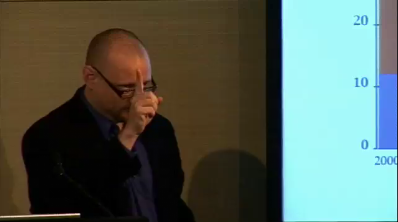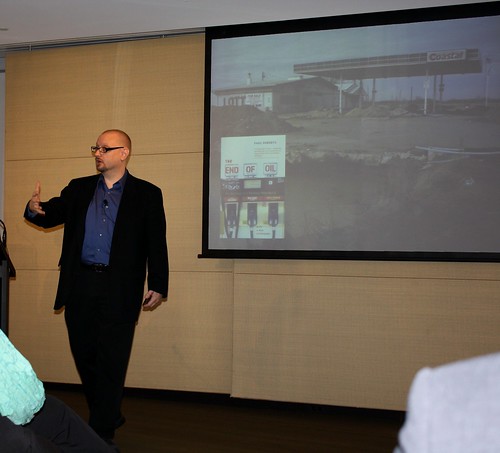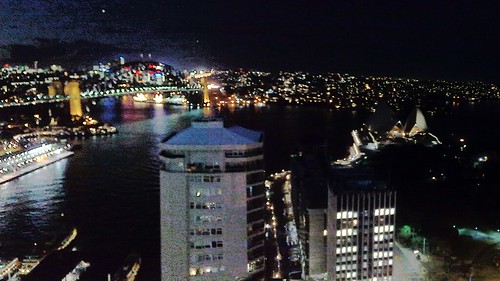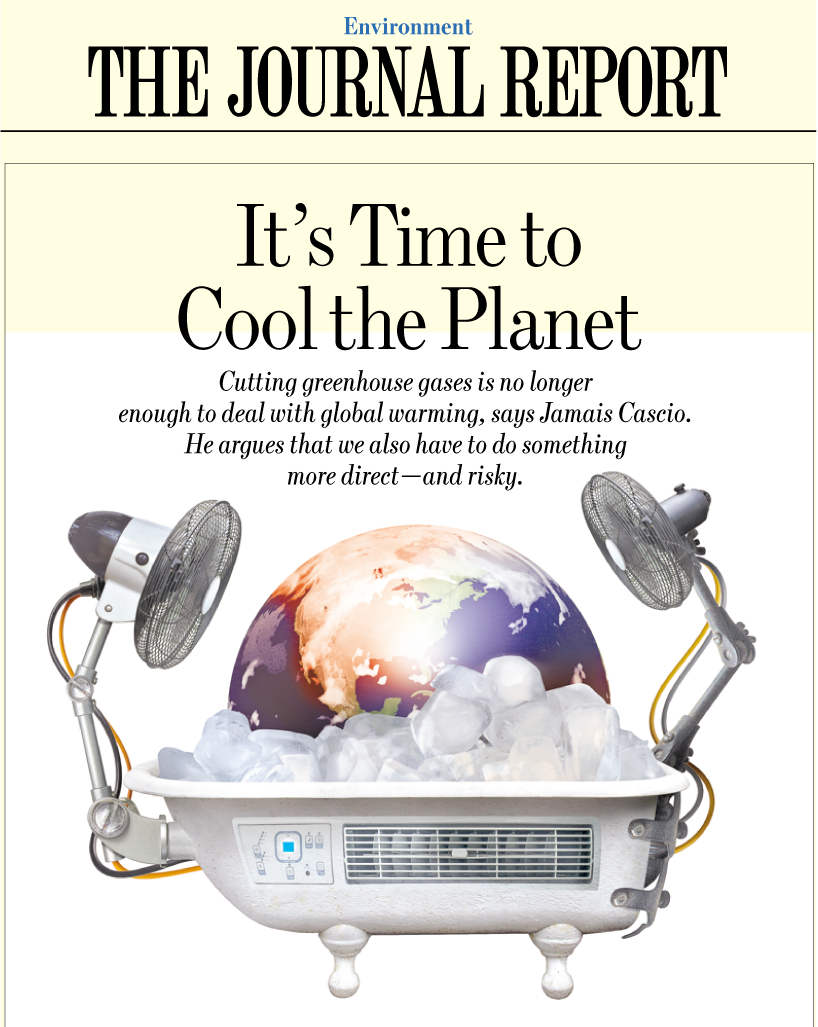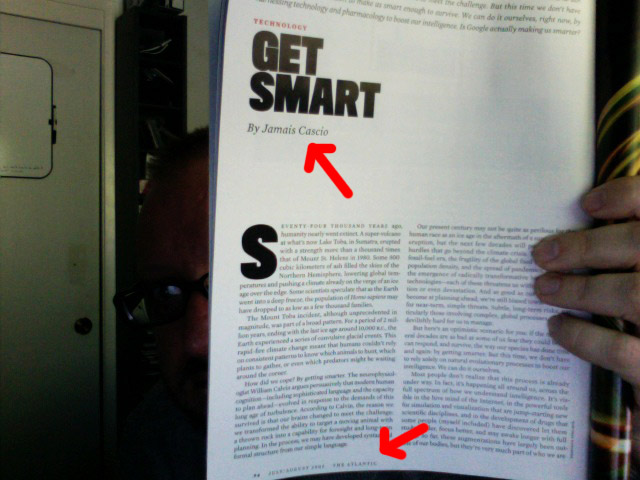« May 2009 | Main Page | July 2009 »
Monthly Archives
June 25, 2009
June 24, 2009
Your Brain Hates You
The "blue" and the "green" are identical colors (RGB 0/255/150). Discuss.

Yes, they are. Grab this image and test the colors yourself.
From Phil Plait, the Bad Astronomy blogger, who says:
The orange stripes go through the "green" spiral but not the "blue" one. So without us even knowing it, our brains compare that spiral to the orange stripes, forcing it to think the spiral is green. The magenta stripes make the other part of the spiral look blue, even though they are exactly the same color. [...]This is why I tell people over and over again: you cannot trust what you see even with your own eyes. Your eyes are not cameras faithfully taking pictures of absolute truth of all that surrounds you. They have filters, and your brain has to interpret the jangled mess it gets fed.
In other words, your brain hates you.
June 23, 2009
Sydneyside
Presentation #1 done. They scheduled me for 7:30 in the morning, so the crowd was lighter than I expected. Fortunately, my body was still on California time, so 7:30 in the morning felt like early afternoon for me!
A few meetings today, then a repeat of the talk tomorrow afternoon.
There's an audio recording of the talk out there, but the quality is pretty bad -- wildly variable volume and bursts of static. Hopefully, there will be a cleaned-up version.
Here's my slide deck at Slideshare. Many of the slides will be familiar -- as you know, I'm a great believer in recycling.
(UPDATE: Okay, here's the audio. They cleaned it up -- although it still starts with a loud static blast, sorry -- but there's occasional dropout. If you listen to it with the slideshare file open, though, you should be able to follow along and pick up what the mic didn't.)
June 21, 2009
Worry. Be Happy.
On Wednesday morning, I'll be presenting at AMPLIFY 09 in Sydney, Australia. The topic of my talk? "What if we really COULD change the future for the better?"
It's at once a bit unsettling and a bit of a relief to be speaking about this subject again. I've spent so much time, of late, writing about and talking about Big Hairy Crises and Our Failure to Confront Them (tm), that I almost forgot what I should be doing. In a way, it's good that the Atlantic article was delayed so long; it ended up being a nice reminder that not all of my work has to be so dire.
Pictures, etc., to follow as usual.
June 18, 2009
New FC: #cleanse
 My new Fast Company article went live this morning, "The Dark Side of Twittering a Revolution." It looks at some of the less-savory implications of the heroic use of Twitter in Iran.
My new Fast Company article went live this morning, "The Dark Side of Twittering a Revolution." It looks at some of the less-savory implications of the heroic use of Twitter in Iran.
Consider, for a moment, what we're seeing happening in Iran: mass-action coordinated, at least in part, through Twitter; traditional media in Iran having lost any legitimacy for the angry populace, alternative media--like Twitter--increasingly becoming the sole source of information; and a growing sense of persecution and crisis, abetted by the limited streams of rumor-heavy news. Let me again emphasize that I don't think that what's happening in Iran is a misuse of social media; what I do think is that the same kinds of dynamics that have allowed for a potential democratic revolution in Iran could emerge just as readily in support of something far darker.
Just as radio was used to great effect by those seeking to unleash genocide against ethnic rivals, social media like Twitter is likely to be used at some point to do others harm.
(The title of this post -- and the image above -- will make sense when you read the FC article.)
June 16, 2009
Get Smart(er)

Image by Anastasia Vasilakis for The Atlantic
Big Media #2, my Atlantic Monthly article, hit the web today: Get Smarter (or "Get Smart" in the print edition).
Our present century may not be quite as perilous for the human race as an ice age in the aftermath of a super-volcano eruption, but the next few decades will pose enormous hurdles that go beyond the climate crisis. The end of the fossil-fuel era, the fragility of the global food web, growing population density, and the spread of pandemics, as well as the emergence of radically transformative bio- and nano technologies—each of these threatens us with broad disruption or even devastation. And as good as our brains have become at planning ahead, we’re still biased toward looking for near-term, simple threats. Subtle, long-term risks, particularly those involving complex, global processes, remain devilishly hard for us to manage.But here’s an optimistic scenario for you: if the next several decades are as bad as some of us fear they could be, we can respond, and survive, the way our species has done time and again: by getting smarter. But this time, we don’t have to rely solely on natural evolutionary processes to boost our intelligence. We can do it ourselves.
This article brings together a number of the themes that infuse my work, from augmentation to environmental threats to the need to have a hand in shaping our own futures. There are a few lines, here and there, that long-time readers will recognize, but there's a lot of new stuff, too, ideas and arguments I've wanted to explore, but have been waiting for this to hit before doing so.
It's been a long wait. A little less than a year ago, Atlantic Monthly editor Reihan Salam asked me to write a piece for the magazine. Initially aimed at the November 2008 issue, it was to be a fairly direct reply to Nick Carr's "Is Google Making Us Stupid?" article of the July/August 2008 issue. Little things like a historic election intervened, however, and my article got bumped; it resurfaced this Spring, when Reihan brought on a terrific editor, James Gibney, to shepherd it through to print.
I'm very happy with the result, and I greatly look forward to hearing your responses and critiques.
June 15, 2009
BREAKING: "San Francisco Futurist" Causes Exploding Heads
Imminent Death of Wall Street Journal Expected
Apparently, I'm a "kook," "insane," an "idiot," and should be "tied to a rocket ship and shot into the Sun."At least according to the people who took the time to write to the editors of the Wall Street Journal in response to my essay. (All of the letters-to-the-editor emails on the article are being forwarded my way.) Sometimes, they noted that they were canceling their subscription to the Journal, and one person graciously included the letter that he had sent -- via paper mail -- to the editor-in-chief, who may not know what his devilish underlings had gotten themselves into.
A good friend of mine who braved the free-fire zone of the actual comments section reports that the nicer things people had to say were that I should "sell [my] mansion", "write science fiction" and "dress like dr. evil." (Sorry, I don't look good in all-white.) Others report ongoing jokes about my name, and a couple of folks who apparently now hate me with a white-hot passion.
So it goes.
June 14, 2009
WSJ: It's Time to Cool the Planet
In which I admit that I have become a reluctant geoengineering advocate.
To their credit, the Wall Street Journal editors I worked with gave me absolutely no push-back about including numerous strident calls for carbon emissions elimination alongside geoengineering.
To be clear, geoengineering won’t solve global warming. It’s not a “techno-fix.” It would be enormously risky and almost certainly lead to troubling unforeseen consequences. And without a doubt, the deployment of geoengineering would lead to international tension. Who decides what the ideal temperature would be? Russia? India? The U.S.? Who’s to blame if Country A’s geoengineering efforts cause a drought in Country B?Also let’s be clear about one other thing: We will still have to radically reduce carbon emissions, and do so quickly. We will still have to eliminate the use of fossil fuels, and adopt substantially more sustainable agricultural methods. We will still have to deal with the effects of ecosystems damaged by carbon overload.
But what geoengineering can do is slow the increase in temperatures, delay potentially catastrophic “tipping point” events—such as a disastrous melting of the Arctic permafrost—and give us time to make the changes to our economies and our societies necessary to end the climate disaster.
Geoengineering, in other words, is simply a temporary “stay of execution.” We will still have to work for a pardon.
That said, I have no desire to wade into the fever swamps that the comments section for this piece will shortly become.
June 12, 2009
Understanding Geoengineering
While in Amsterdam, I had the pleasure of meeting with the group FreedomLab. They interviewed me on a series of topics, including geoengineering; a DVD of the interview will be available in the next few weeks. In the meantime, in connection with Monday's publication of my piece on geoengineering for the Wall Street Journal, they've sent me some of the clips where I talk about the subject.
Here's the first, What is Geoengineering?:
What is Geoengineering? from Jamais Cascio on Vimeo.
Four more videos -- The Geoengineering Dilemma, The Political Aspects of Geoengineering, Catastrophe or Radical Action?, and The Anthropocene and Human Responsibility -- below the fold.
As always, feedback is more than welcome.
The Geoengineering Dilemma from Jamais Cascio on Vimeo.
The Political Aspects of Geoengineering
The Political Aspects of Geoengineering from Jamais Cascio on Vimeo.
Catastrophe or Radical Action?
The Anthropocene and Human Responsibility
The Anthropocene and Human Responsibility from Jamais Cascio on Vimeo.
Big Media
This next few days sees a big print media splash the likes of which I've never experienced. The July/August issue of The Atlantic Monthly, now on sale, has my long-awaited (at least by me) article on cognitive augmentation, "Get Smart." The Atlantic website will be updated with the new issue Real Soon Now, I'm promised. And on Monday, my cover story for the Wall Street Journal's Special Report on the environment, "It's Time to Cool the Planet," hits both the streets and the web.
I'll have links to both when available, of course, but didn't want to bury this over the weekend.
June 11, 2009
New Fast Company Column: iPhone Augmented Reality
Because it's actually a blogging requirement to write something about new Apple hardware when it's announced.
One of the more important features of the new iPhone may be the least-widely heralded by the tech punditry: it has a compass.This matters not because now you'll always know which way is North with the iPhone, or even because you can make a quick-and-dirty metal detector with it. It matters because it finally opens up the iPhone to real augmented reality. In that august position, it joins the ranks of a handful of other smartphones, including (in particular) the Android G1 and the Nokia N97.
Of course, I say that about the Nokia N97 simply due to tech specs and early reviews, not because I have my hands on one. Just saying.
June 5, 2009
Mobile Intelligence
Video of my Mobile Monday talk now up:
June 2, 2009
Mo' MoMo Pics
Mobile Monday Amsterdam #11 may be the most -- and best -- visually-documented event I've ever done. Both official photos and casual audience pictures captured a good percentage of my talk, as well as some of my pre- and post- activity (or, in some cases, lack of activity).
Here are some of my favorites on Flickr (beyond the several I posted/linked to yesterday):
(Update: moved to the extended entry)

(Photos by Jöran Maaswinkel)
Of course, they took pictures of everyone who presented, so check out Flickr tag MOMOAMS for the fun.
Mobile Monday
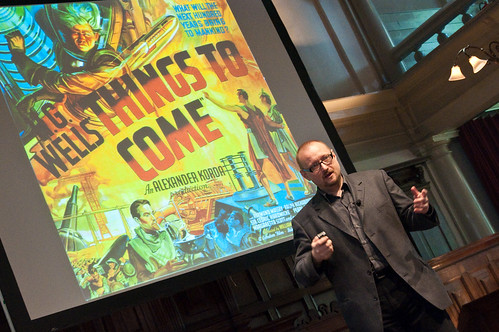
The presentation went well. There should be a couple of videos available shortly -- the official one, and one recorded by Howard Rheingold.
Here are the slides for my talk. This is the raw Slideshare version, with a few minor flaws; I'll have to tweak the Keynote document to make a smoother conversion.
A few other shots of my talk:
(Update: moved to the extended entry)

As always, comments welcome.
(Photos by Anne Helmond, Mark A.M. Kramer, jkivit, and mathysva respectively)
Jamais Cascio
Director of Impacts Analysis, Center for Responsible Nanotechnology
Fellow, Institute for Ethics and Emerging Technologies
Affiliate, Institute for the Future
Recent Posts
Site Info
Tag Cloud
- Apocaphilia
- Artifacts
- Artificial Intelligence
- Augmentation
- Augmented Reality
- Bruce Sterling
- Center for Responsible Nanotechnology
- Cheeseburgers
- China
- Climate Change
- Disasters
- Economics
- Eschatology
- Ethics
- Fabrication
- Fast Company
- Foresight
- Futurism
- Games
- Geoengineering
- Global Guerillas
- Global Politics
- Global Warming
- IFTF
- Interview
- Metaverse
- Metaverse Roadmap Project
- Nanotechnology
- Open Source
- Participatory Decepticon
- Participatory Panopticon
- Podcast
- Politics
- Presentations
- RU Sirius
- Resilience
- Robotics
- Scenarios
- Self-Congratulations
- Simulation
- Singularity
- Social Technology
- Speaking
- Sustainability
- Talks
- Terraforming Earth
- Travel
- US Politics
- Video

